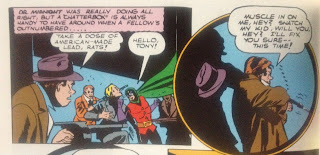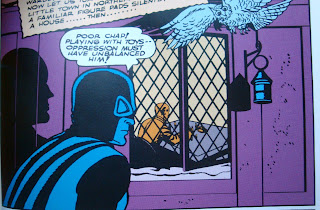It starts at a steel factory not far from Hawkman's territory, where a German bloke named Buehler has managed to get a job at the factory so that he can persuade the workers that the steel factory owner, who has always been kind to them, is making a fortune off of their sweat, and must be taking more than a fair share. An uprising seems evident, until Hawkman, with the aid of two young men (one the steel factory owner's son, the other one of the employees' sons, both best friends since youth) put a squash to it and expose the Nazis plan to bring a halt to steel (and thus armament) production during the war.
The Dr. MidNite tale is a bit more somber than has been customary for the Doc in past issues. The reader is greeted by what looks almost like a spectral version of an old-school gangster named "Tough Tony Scarlotti," who talks about what a terrible youth he was and how he strives for his son, Tony Jr, to be a better person.
What could have quickly devolved into a typical punch-em-up caper is a heartfelt tale about racism in America. Tony Jr has been getting into fights and even taking a black eye or two, but not because he's starting trouble. No, it's because he's been standing up for kids who have been picked on because of their ethnic background.
The prejudiced ideas are being planted into the children's heads by members of the Axis powers, who are working covertly in American to spread hate. That's when Dr. MidNite gets involved (also because Tony Jr is a member of the Junior Justice Society of America, which any kid could join back in the 40s, for a few cents and mailing in the certificate found in the comics The membership materials, including the Junior Justice Society badge are worth hundreds of dollars today).
When the spreaders of hate-filled racism find that young Tony is trying to teach the neighborhood kids better, they decide it's time to get the little squirt out of the way, kidnapping him. While he's eventually rescued by Dr. MidNite, rats kidnapping his son does not set well with Tough Tony, who pulls out his old "chatterbox" and drops in as Dr. MidNite tangles with the enemy.
Of course, Tony ends up a bit in over his head, and finds himself on the other end of the gun for a change. He dies, but as he tells both Dr MidNite and the reader, he's dying happy, knowing the boy he raised is a better man than he.
Written by Gardner Fox and drawn by Stan Asch (the same guy who handles art chores on Johnny Thunder), this short tale really holds up today, delivering compassionate thoughts on where the country stands with its melting pot status, and how words of hate can quickly turn to violence and death. Definitely a stand out.
The Atom finds himself also at odds with those who wish to spread messages of hate and intolerance across America (noticing a theme yet?), only he is dealing with the workers of a coal mine.
 In fact, the story opens with the Atom single-handedly propping a mine shaft on the verge of collapse. As the miners rush to safety, the mine gives way and The Atom, tapped beneath the rubble, recalls how he got into this mess.
In fact, the story opens with the Atom single-handedly propping a mine shaft on the verge of collapse. As the miners rush to safety, the mine gives way and The Atom, tapped beneath the rubble, recalls how he got into this mess.The son of one of the miners (also a member of the Junior Justice Society) informs the Atom that his father and other workers are being told that the mine's owners, because they are foreigners, don't care at all about the workers and that the mine's are a dangerous place for them to be working. They want the workers to turn against the owners, solely on the base of what country they were born.
While the workers, at first, don't buy into the propaganda, once The Atom addresses the crowd about the safe conditions and not judging people by their birthplace, the propaganda artists decide to set off explosions in the mine and prove their point.
Bringing us to the present, The Atom is thought to be dead by the miners, who are starting to believe the hate-message about the mine's owners. That is, until The Atom, who managed to survive, comes forth and lets the workers know who was really behind the explosion.
Dr. Fate's got a mystical foe on his hands, or so that foe would like the public to believe. A so-called prophet calling himself "Mr. Fortune" blows into town in a nice suit and turban, reading fortunes and giving residents a glimpse of what's to come. When the incidents start to actually happen, the town goes into a panic, and is ready to do anything Mr. Fortune tells them.
 Of course, this turns out to be nothing but a ruse. Once Mr. Fortune builds the public's confidence in himself, he can spread the hate of the Axis Powers, his true intention after all. When Dr. Fate tries to intervene, the public turns on the hero, taking Mr. Fortune for his word that Dr. Fate is "un-American."
Of course, this turns out to be nothing but a ruse. Once Mr. Fortune builds the public's confidence in himself, he can spread the hate of the Axis Powers, his true intention after all. When Dr. Fate tries to intervene, the public turns on the hero, taking Mr. Fortune for his word that Dr. Fate is "un-American."Naturally, all goes well in the end and Mr. Fortune is exposed as a fraud, but I can't help but mention how much I dug the name of "Mr. Fortune" as a villain. Sure, his look was typical 1940s villain (a suit), with the addition of the turban, but something about it just worked for the Golden Age.
I also have to wonder if his look helped inspire the character of "Sir Swami" from the Justice League animated series (by Bruce Timm, Paul Dini, Alan Burnett, James Tucker, Dwayne McDuffie and company), in an episode that put the League in an alternate dimension with clean-cut heroes and villains that slightly resembled the heroes and rogues of the Justice Society stories of the 40s. In this case, Sir Swami was a stand-in for JSA villain, "the Wizard," but his look certainly seems to come heavily from Mr. Fortune.
Alas, as interesting as he is in a very simplistic way, I've yet to find reference to any other appearances by Mr. Fortune with the JSA or Dr. Fate.
 The Sandman, meanwhile, is haunting the dreams of Henry Overman, the publisher of a newspaper called "The New Way," meaning a confrontation between the two will soon come to pass. Once again, beautiful art by Joe Simon and Jack Kirby.
The Sandman, meanwhile, is haunting the dreams of Henry Overman, the publisher of a newspaper called "The New Way," meaning a confrontation between the two will soon come to pass. Once again, beautiful art by Joe Simon and Jack Kirby.Using his newspaper, Overman, working for Hitler and the Third Reich, is publishing false articles, supposedly by "experts" that state the American forces are in pretty bad shape when it comes to the war, and are facing a losing battle.
Overman hopes this will raise doubt in American citizens and stop them from buying war bonds to support the forces.
With the help of the newsies who didn't realize they were on the street peddling a Nazi paper, The Sandman brings the publication to a halt.In the end, the newsies realize they all come from different ethnic backgrounds and get along fine, so why should it make any difference in other parts of life?
Starman finds himself in a similar boat, racing to the midwest to get to the bottom of a near-revolt by America's farmers. It seems some strangers have blown into town and planted the bug into their ears that they should be getting paid more for their crops, and that the middlemen and the shops are taking far more than they deserve.
Just to be clear, this is a very real problem, even in today's world, where farmer's receive far too little for the necessary crops they grow and provide our dinner tables with. I have a great admiration for the work farmers too, but also a great sympathy for the way they are treated or poorly compensated for such a necessity.
On the night of a vote by the farmers to decide whether or not to stop growing, Starman intervenes and reveals the new men in town as nothing more than Nazi propaganda artists. Seeing that they were being duped by Nazis who hoped to damage the American crops, and morale at home and on the front lines, the farmers decide it's best during the course of WWII to keep things running as-is for the greater good.
In another factory, elsewhere in the country, another troublemaker has broken into the company safe to steal secret documents with the sole intention of planting them on someone of an ethnic background to create friction. Posing as a factory worker and befriending a man name Jan Seybowsy, the Axis spy has found his target. Planting the stolen documents on Jan, the rest of the factory workers quickly turn against him and open their ears to what this stranger has to say. When The Spectre gets word of this, he spirits the evildoers away to the far reaches of space, and a fiery planet where the Nazi is convinced he's burning in hell. The Spectre even take on the frightening form of Satan to push the villain over the edge.
When the man is returned to earth, he has been so frightened that he tries to contact the mother country by radio. When he does, it's before an audience of factory workers and townspeople brought over by The Spectre, who quickly realize they've made a mistake, running the Nazi muckraker out of town, and apologize to Jan for their quick emotional reaction without thinking.
Johnny Thunder (still wearing his Naval uniform) is on the lookout for the Nazi propaganda culprits when he stumbles into a meeting where he unwittingly (is there ever a time that Johnny does something wittingly?) gets caught up in the discussion and ends up making the propaganda speech himself. When he realizes what he's done and the people who led him down this not-so-rosy path, he and his magic Thunderbolt quickly go to work exposing the truth.

The story wraps with the entire Justice Society making an appearance at a War Bond rally at a theatre, where they introduce the audience to the various hard-working Americans across the country, from the miners, the farmers, the women in the factories, the mothers at home, and more.















































